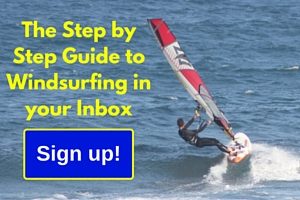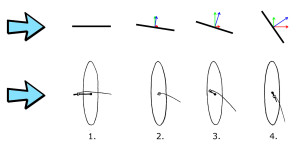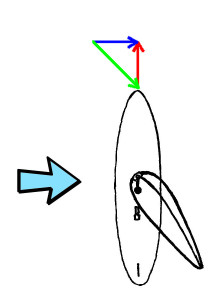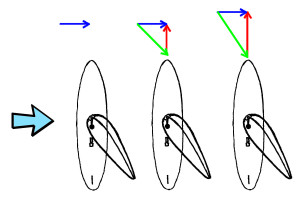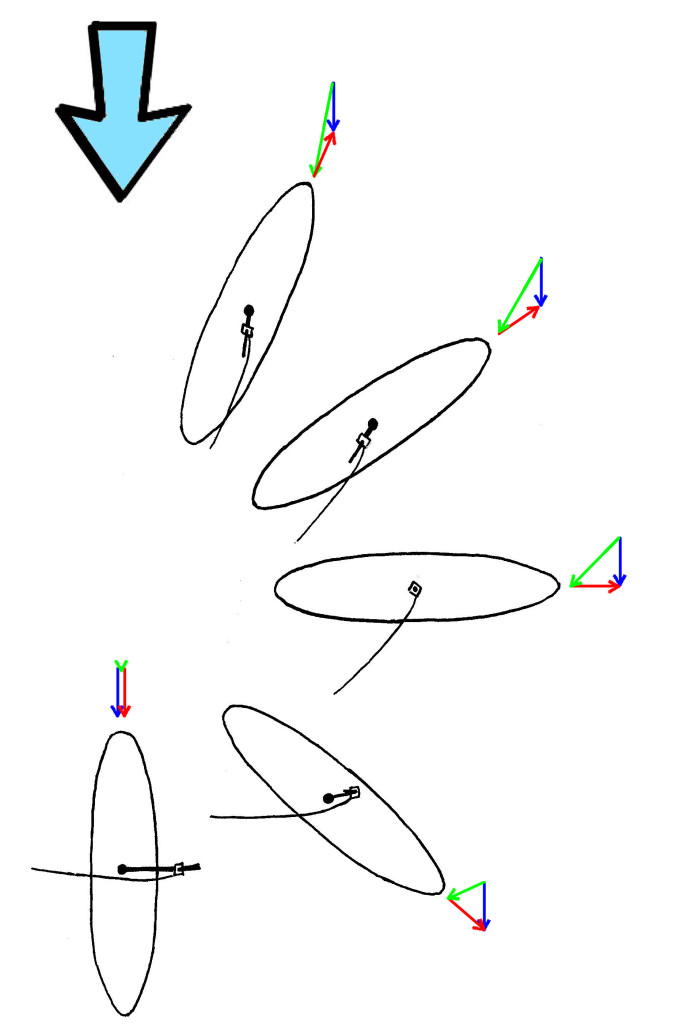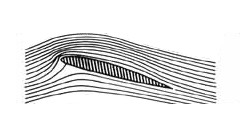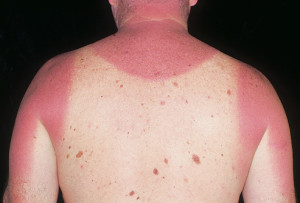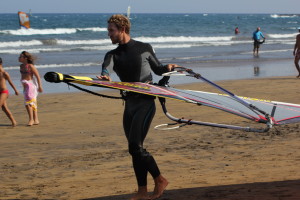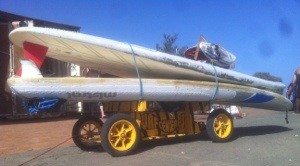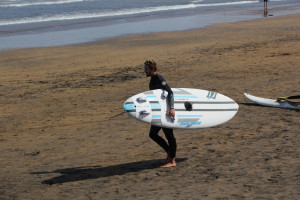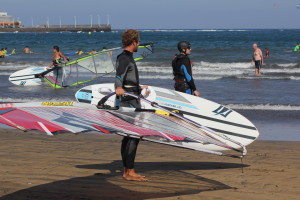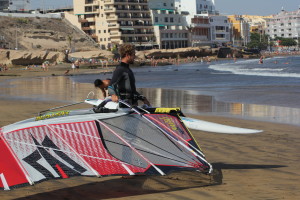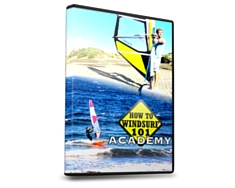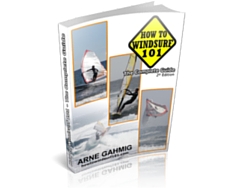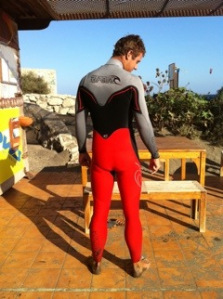
5 things to remember when buying a wetsuit
This is a post I wrote a year ago on an old blog and thought I would post it on here also.
When we need to buy a wetsuit there are a couple of things we have to take into account. We have to ask ourselves questions such as:
- What sport do we want to do with it?
- What temperatures are we going to use it in?
- How long will the sessions be that we use it?
The basic things to look out for are:
Thickness
Depending on the temperature of the air and water that you are going to be in and the length of time that you are going to spend in it you will need a different thickness of wetsuit. It hardly bears mentioning that warmer waters require less thickness than cold waters. Also, you may be in a country where the actual temperature is warm but the water is cold so bear that in mind.
I was surfing in Portugal in July and despite the heat on the shore (and boiling inside the wetsuit) the water was rather cold and only permitted sessions of around an hour with long wetsuits.
Naturally ones body constitution will have an impact on the thickness you need. I have seen guys in the water in board shorts while others needed long suits.
Then again, if you are windsurfing and you are rarely in the water and the air is warm, maybe a thinner one will do.
read more…
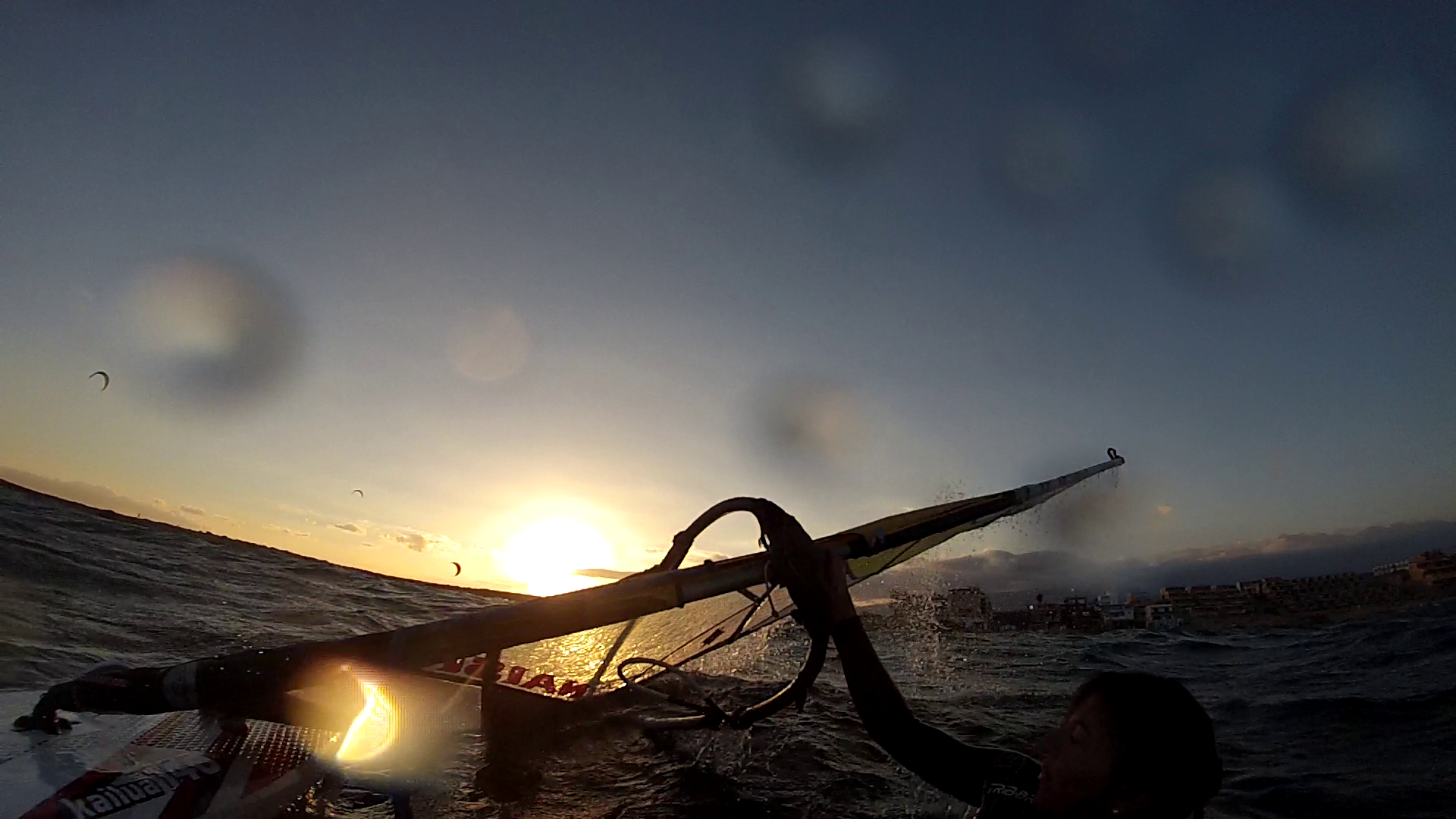
Lifting the sail out of the water for the waterstart
The waterstart could be an easy and energy saving way to get going again after falling in the water. However, a lot of the time I see how people on a more advanced level (such as learning how to gybe in lessons with me) waste a lot of energy on the waterstart. In my previous post on how to waterstart I only focused on the waterstart itself and skipped the part on how to get the sail out of the water or position the gear. In this post I will focus on how to lay out the gear and lift the sail out of the water in the most energy efficient way so that your sessions on the water can last longer.
Check the wind direction
Missing this small little detail is by far the one which has robbed the most people of a lot of energy. By trying to lift the sail out at an angle which has the wind pushing down on the sail rather than going underneath it and lifting it up, many windsurfers end up tired in a matter of minutes. Before you do anything in terms of handling the gear or making a physical effort for the waterstart, take a moment to ensure you have a clear notion of the wind direction.
Put the sail on what would be/is the upwind side of the board when the board is pointing in the direction we want to start in
Let’s assume we want to start on a starboard tack. If we have the sail on the upwind side of the board, all we have to do is turn the board under the sail (if necessary) so that it is set out on the starboard tack. If the sail were laying downwind of the board, simply lay out the board so that if the sail were upwind, it would be set out for a starboard tack.
Position the sail so that the mast is on the sailing direction and the clew is on the aft side of the board
If the sail is not already laid out like this, we must flip the sail. The way we do this is by positioning the clew upwind of the mast and starting to lift the clew out of the water until the wind gets some of the sail surface and helps you by pushing the clew all the way on to the lee side.
Turn the gear so that the mast is between 20° and 90° to the wind
There are two ways we can turn the gear. I generally recommend considering the mast top as the centre of rotation and making the board move around it, always with the bow first (as this is the natural direction to move in and will be wasier). The exception is when the gear is practically already correctly laid out and all that is needed is a few more degrees around. It is more effective to swim 20° in the unnatural sense than 340° in the natural one. I recommend grabbing the mast between the boom and the mastfoot and swimming paraell to the board.
Swim to the correct position along the mast
The closer the sail is to 20°, the higher up on the mast we must position ourselves to start lifting up the sail. The closer to 90° the sail is to the wind the closer to the boom we must position ourselves. At the 90° mark we must be at around 60 cm (2ft) above the boom.
Swim to the wind until the sail is flat on the water surface
Start swimming towards the wind with the mast in hand until the sail is lying flat on the water. Do not lift the mast out of the water until the sail is flat on the water as if the clew is still to deep in the water when you lif the sail up, the wind will blow the sail out of your hand and over the clew instead of getting the rest of the sail out of the water smoothly.If the clew is in the water you will not be able to hold it when the wind hits the sail, and if you are able, all that is going to happen is that the sail sinks into the water again.
Lift up the sail slowly and don’t stop swimming
With the sail flat on the water we start lifting the sail with constant upward force. Do not jerk it upwards. The water on the sail will keep the sail from going up and all you are going to do is waste energy. Lift up the sail slowly so that the water can run out of the sail as you slowly lift it up. Slowly lift the mast about 30 cm (1 foot) over the water surface so that the wind can do the rest of the sail lifting for you. Do not stop swiming towards the wind or the clew will start to slip deeper into the water.
Set up for the waterstart
Now all that is left is to move the sail over your head and grab either the boom or the back footstrap with the back hand and you are set to tackle the waterstart itself.
So to recap:
– Check wind direction
– Set up board relative to the sail first
– Then rotate to get mast between 20 and 90 deg to the wind
– Grab mast and swim towards the wind until the sail is laying flat on the water
– If the sail is not flat in the water it can get stuck in the water an undo all the progress.
– Start lifting the sail by continuing to swim towards the wind and lifting it up slowly but steadily.
– Do NOT jerk it upwards as tere is water weighing the sail down and will just use a lot of energy for little result.
– Slow steady lifting up so the water can roll off the sail.
– Raise it up to 30 cm so the wind lifts it up completely
– Do waterstart
Windsurfing Through Waves
My home spot is El Médano. It is where I learned to windsurf and where I have been teaching for the last 9 years on and off. In that time I have seen hundreds of people keen of getting on the water and having a great session suddenly experience a frustrating fight for even getting on the board and sailing for more than 10 meters. I have seen experienced flat water windsurfers take a severe beating and break gear on many occasions. The reason is that they never had to face a shore break, much less such a constant one as here. And it really isn’t all that hard getting through the waves, all you need to know is how.
We need to take into account that regardless of whether you are positioning the board for the beachstart, the waterstart of just plain sailing, the method to get through a breaking wave is the same. The biggest fight that I keep witnessing is to do the beachstart. The reason is that the waves tend to come non-stop, with a space of 1 to 5 seconds between them. Here are the three basic things you need to take into account when going through a shore break wave:
Go through the wave at 90°
This is the biggest factor to take into account when sailing through a wave, broken or just steep. The wave is a mass of water that is moving towards you that will try to push us along with it, and if the board is not perpendicular to the wave, the bow (which is the first point of contact of the wave on the board) will be pushed/dragged along by the wave. The result is a loss of control. If this happens while positioning the board for the beachstart or the waterstart, all our positioning efforts will have been undone. If this happens while sailing, the result is either a way too fast luffing up to the wind, or a very entertaining catapult (at least for all of us watching :))
The faster the better
As mentioned before, the wave has a lot of inertia, meaning that when it hits us, it will try to push us with it. Hitting it at 90° is one part of the equation, however, unless we have some energy of our own to counteract the waves’ energy, it will in fact push us backwards. While handling the board for the beachstart we can lean against the wave with the gear to stop it from pushing us over although pushing the gear into the wave about a meter before impact is more effective. If we have to waterstart in steep/broken waves, pushing towards pushing the board into the wave like with the beachstart can make the difference of having to lay out the gear correctly again or not. When we are sailing, try to pick up some speed between the waves so that you are not at a standstill when the wave hits you. The faster you are going, the less the wave is going to affect you.
Bend your knees on impact
As I mentioned above, the wave will slow us down in some measure. In the same way that if we hit a curb with the bike or get a stone under the wheels of a skateboard, if our weight centre is high up, we will be more likely to fly over forwards. The solution in windsurfing is to bring our upper body lower by bending our knees just before hitting the wave head on.
One more thing:
Another little tip you can implement is make sure you have the weight on the back foot so that the bow comes up a little and the board can go over the wave naturally and not necessarily underneath/through it.
This advice is mainly for the conditions in El Médano where the wind usually comes side-on. With offshore winds, the advice is still pretty much the same with the small additional hint that we must remember to open the sail right after the wave because the difference in height before and after the wave makes the air speed up, which feels like a sudden strong gust normally resulting in a silly twirling fall over the lee side.
I hope this has provided some insight as to why your efforts in waves have been more challenging, exhausting (maybe even frustrating) and that you are now equipped with the knowledge of how to overcome even the bigger whitewash.
9 Things that Make a Good Windsurf Instructor
This is a post I wrote a while back for another blog in which I detailed some important features people whould have who were aspiring to become windsurf instructors. However, you can also read this as a bit of a guide as to what to look for in a windsurf instructor in order to have the most out of a lesson with them.
9. Charismatic
This is secondary but in many places it is the responsibility of the instructors to get their own students meaning it is up to you to approach people and offer then the opportunity to experience the awesome sensation that our particular sport brings with it. I’m just saying that being charismatic in this case helps. It is also more likely for a student to return if they felt comfortable with their instructor.
8. Speak the language of the student
I don’t speak Russian to the extent of holding a conversation. I do however know a number of phrases along the lines of “front arm straight”, weight on the back foot”, “back straight and other basics along these lines. It reduces the likelihood of your student misunderstanding a movement of yours that they must imitate.
This might not be a crucial necessity but it helps a lot if you can explain something in words while the student puts it into practice without having to look at you so they can concentrate on the manoeuvre or conditions (like waves or gusts).
Of course we do not depend on auditive communication only, whats more, the student will learn faster if you make them use all their senses, but being able to communicate in the same language will avoid them to focus on the wrong thing or get a different message.
7. Know the sport inside out
You have to be able to explain every reaction of the kit caused by any alteration done by us, be it practical, like why the board turns when we move the sail, or technical like what happens when we tense the downhaul or what the purpose of the loose leech is.
read more…
Spin Out – Causes and How to Avoid Them
Spin out: the situation in which the flow of the water along the fin breaks off causing the board to slide sideways or at an angle to the sailing direction.
So there you are, planing along, flying over the water and enjoying the sensation of speed when suddenly the aft end of the board slides away from under you. The result of a spin out will vary depending on the circumstances. While just cruising it will just be a nuisance which is corrected with a little bit of technique. When wave riding it is mostly what we aim for in a cutback to get big spray, hence the reason for small fins and/or multiple fins. On the bottom turn it might cause a more precarious situation ending in a faceplant followed by a nice and thorough wash of the wave. And in slalom sailing, a spin out might result in a coma in the worst case scenario although most likely it will just cause a big splash and a scare if it isn’t avoided or corrected in time.
Why does spin out occur?
The reason for a spin out occurring is that the sideways force transmitted from the sail, through our body and onto the fin is so great that the flow of water breaks off and the back of the board is pushed to the side.
How can I avoid spin out?
There are several things that we can modify. First, in terms of equipment, it’s all about the fin. The length and angle of the fin as well as its relation to the sail size determine both the amount we can go upwind and the likelihood of a spinout.
Another deciding factor is the amount of pressure we put on the back foot and therefore on the fin.
How do I recover from a spin out?
Once the board has given way, leewards, we can correct it by putting pressure on the mastfoot with our bodyweight while pulling the back foot back to put the fin back in line of our movement, ie. in line with the flow of water.
If the fin spins out upwind (like during a gybe or a bottom turn) there isn’t really much you can do besides hope you don’t wreck your kit.
Hope this helps avoid or correct those spin outs you’re having. If you want some more information on spin outs check out this post by Tom von Alten.
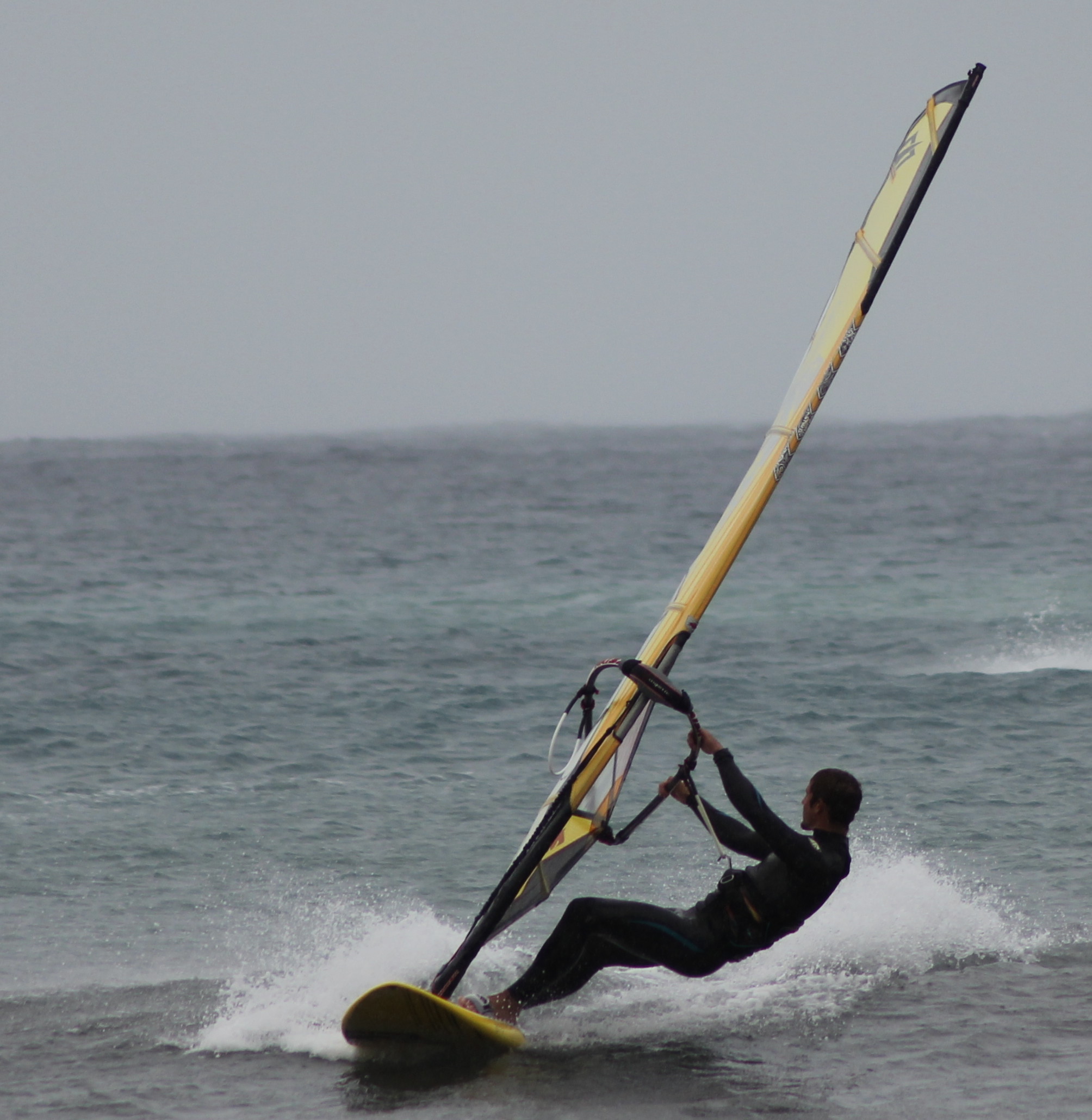
How to Windsurf – Planing
Flying over the water is an amazing feeling. One that I try to have every student of mine experience in their first lesson with me, which isn’t too hard considering that in El Médano we tend to have 20 knots and I am pulling them behind me with an elastic rope. Once you have felt what windsurfing can be, or rather, what windsurfing is all about, you are hooked. It is an amazing feeling and yet one that many people haven’t gotten the hang of properly despite advancing to more complex maneuvers. Even if it consists of only sailing back and forth, windsurfing consists mainly of sailing back and forth with some sporadic maneuvers in between. Learning to plane comes somewhere between learning to use the harness (making it easier to hold the power in the sail required to start and continue planing) and the foot-straps (which are only really useful to use when planing). You can start planing hooked in or hooked out of the harness depending on how well you can cope with the sudden increase of power in the sail and how well you react to gusts, waves and choppy water.
I can start planing on a 100 l and 5.7 when many others are struggling on their 130 l and 6.6. This is purely because of technique. Sure, having a bigger board and bigger sail helps, but the correct technique makes up for much more. Make sure you spend some time working on your planing technique and your suture sessions will be much more enjoyable as the range in which you can start to have fun on the water will be much larger.
First off, what is planing?
When we start to windsurf, the board sits in the water and begins to move through it much like a container ship would. However, as we pick up speed the boards lifts out of the water and we start to bounce over it like speedboats do. To get more technical, planing is when we are sailing (or gliding) over the water rather than pushing through it and the water that leaves the aft end of our board does so in a laminar cut-off fashion and not in a turbulent stern-enclosing way.
How to se start to plane? Very easy, by going fast enough. Sounds easy right? Many people will have experienced planing at some point or another when they start to use bigger sails and actually use the power that can be generated by them. However, we want to be able to plane with the smallest sail possible since the larger sails get, the more cumbersome they are. Holding the plane once we start windsurfing fast is not too difficult if we have a good grasp of the relative wind generated by our boards movement. The difficult part is starting the plane.
How to start planing
Check out the video series by Peter Hart
To get our board out of the water we need speed. Better yet, a surge of speed. How do we go about this? By generating a surge of power in the sail and transmitting that power into the board. Let’s look at this step by step.
– Stand upright: do not bend your knees or bring your bodyweight down. Your entire body weight should be used to lean into the wind to counter the pull of the sail once the wind hits without getting catapulted forwards.
– Change the course: Again remembering the wind forces in the sail, if we turn from the beam reach into the broad reach suddenly, the area of the sail will suddenly be creating only lift (because the board is meant to go nearly entirely in the direction of the wind) as the drag force is also going where we want to go.
– Shoulders away from the mast: As explained in the video you need to grab the boom a little further away from the boom with your front hand and lean far back with your body in order to get as much sail surface available to the wind and as much weight back to resist the pull AND to be able to generate a horizontal push on the board with your foot on the board instead of a vertical one with your weight.
– Keep your body tension: The less energy that is lost in this crucial moment the better. We must keep our body tense for these few seconds because if we allow our body to be slack, the pull of the sail will not be transmitted into the board but will be lost and we will have to start over again. Keep your upper body and front leg in a straight line so that you can…
– Push forwards with your front foot (pointing towards the bow). Focus on keeping your hips pushed forwards as letting them go back as their shoulders get pulled forwards is what I have seen many people fail in.
And now to top it all off, we need to do all this in one smooth and fluid movement and not in a jerky way.
Continuing to plane
So now we have managed to start planing. How to we keep it? I say focus mainly on your sail position with respect to the relative wind. Read my post on the physics of windsurfing if your haven’t already done so to read up on the importance of this and how to go about it. With strong wind we will usually find the correct position easily (or the mistakes are compensated for more) but in light winds, the wrong angle of attack on the sail can kill your plane.
Planing upwind
One of the most asked question regarding planing I get is this: how to I sail upwind? The problems are usually that people turn in to the wind too fast and slow down quickly or get a spin out.
The solution to both these problems is a correct body position. While on a beam reach we might still get away with the basic body position I explained in my post on how to windsurf once we start to use smaller boards, this will no longer work. This is because the board will sink easier and because we will most likely be using smaller fins despite generating much more sideways force due to planing.
What we need to do is shift our weight from the back foot on to the front foot and put pressure on the mast-foot while leaning the sail to the back of the board. This may seem like a mouthful but is the most compact way of solving the problem.
We lean the sail back to hold the closed reach, we transfer the weight onto the front foot to avoid a spin out (the back foot in the strap of course, don’t want you making a catapult because of some chop) and the pressure on the mast-foot is to transmit the power of the sail into the board to keep the speed.
I have included a video of me explaining the technique to planing as a bonus to those who purchase my e-guide which you can check out here.
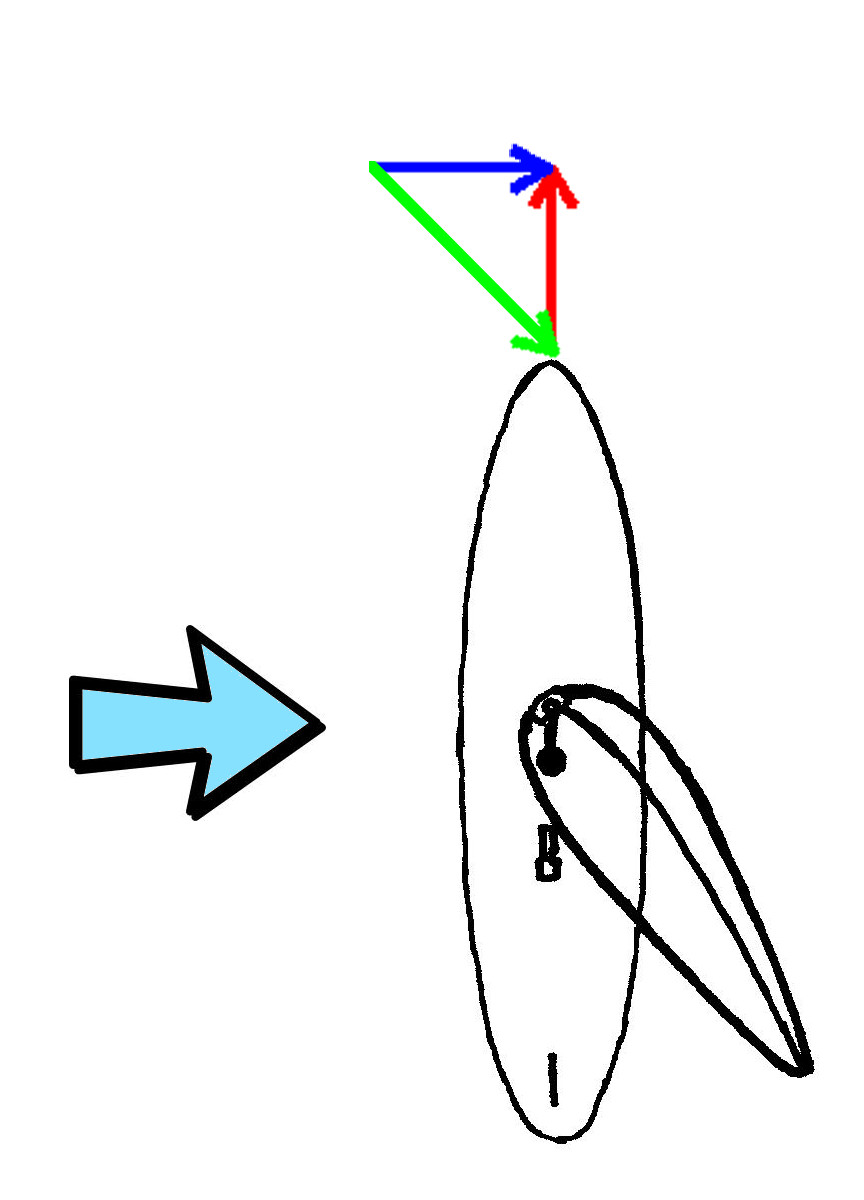
Physics of Windsurfing
Why do I need to know this? Well, although you can probably windsurf by following the indications of an instructor, if you are going to try and learn how to windsurf on your own, understanding thow the sail words will save you a lot of trail and error and frustration and improve our technique so that you can get the most out of the sail enjoy the full range of what is possible in windsurfing especially in terms of speed, the powerjybe and the bottom turn.
How the windsurf sail works
The sail works like the wing of an aeroplane. Funny thing is that I have had students that had taken plane flying lessons have the workings of a wing explained as: “working the same as a sail”. So, let’s explain how a wing/sail works shall we?
Here is a video that explains thie workings of a wing nicely if you can keep up with the speed at which he speaks.
First, let’s pretend the sail is a rigid flat surface. The best comparisson I have is comparing it to sticking our hand out of the window of a car (if you have never done this, you didn’t have a childhood)
When we stick out hand out horizontally, the wind generated by the car hardly affects us.
If we now tilt our hand slightly so the little finger (trailing edge) is lower than the thumb (leading edge) the hand starts to get rise. In other words it generates an upwards force called lift.
However, there is a second force, a sideways force called drag. As we continue to tilt our hand, the lift reduces and the drag increases. Eventually there is going to be more drag than lift and the hand will just be blown sideways rather than up. The same occurs with our sail.
Naturally just a small angle of attack of the sail to the wind only offers very little surface for the wind to generate any sort of force on whereas too much surface (from a too large angle of attack) will result in too much drag. We want to find the sweet spot between getting the maximum lift and generating only as much drag as absolutely necessary.
Relative Wind
So now we know how important it is to find the best angle of attack of the sail to the wind. As we start to sail we only have to take into account the true wind.(blue arrow) As we start to move we start to feel another wind component which we will call the board wind (red arrow – in sailing it is called the boat speed).
If we combine these two wind components we get the wind we feel: the relative wind (green arrow). Depending on which course we are on and the speed we are going at we will get a different relative wind. Since our sail must be positioned at the perfect angle with respect to the relative wind, we must constantly be modifying the sails’ angle of attack to get the maximum speed the wind and sail can allow us.
Here is the relative wind as we build up speed..
And here is an example of how the relative wind varies at the same speed on different courses.
I hope now you get an idea how to get the most out of your sail. Now a small change in how the sail is built to get the most out of the wind.
Sail Profile
Now let’s look at the profile of a sail and the air flow along it.
As you can see, the curve of the sail causes the air particles on the lee side to have a longer way to go than the ones on the windward side.
According to Bernoulli’s Principle this difference in speed creates a difference in pressure, the top side (our leeward side) having less pressure and the underside (our upwind side) having more. Since the pressure acting on our side of the sail is greater than the pressure on the other side, lift is generated and we move forwards.
These two components of lift generation (angle of attack and sail shape) are what makes up move. Understanding this will help us get the most out of our sails in terms of speed and early planing.
I hope this has explained how your windsurfing sail works. For an fun video going through exactly this subject you can check out Surfertoday.com and their post “How does a Windsurfing Sail Work?” If you have any questions, feel free to let me know in the comments.

Avoid Sunburn!
Baz Luhrman had it right. We usually don’t take the time to protect ourselves from the sun. This goes for stretching also by the way. In both cases we are putting ourselves in a very careless and potentially very harmful situation.
But focusing on the protection from the sun, here is a quick explanation of why it is important to take so much care of our skin.
This is a topic that is close to me as two people I knew fell victim to skin cancer. Any type of cancer is a dreadful but there are a couple that can be avoided easily lung cancer being the first by not smoking, followed by skin cancer by reducing our exposure to the sun.
Clothing
Of course this is a bit of a tricky one for anyone who practices an outdoor sport. Luckily for us, we can reduce the exposure also with the use of wetsuits, lycras (when it’s too warm for neoprene) and the application of sunscreen.
The clothing however can only cover so much of our skin. The face is always exposed and body parts such as backs of the hands and feet as well as the lips and ears are often forgotten when it comes to the application of suncream.
Suncream
For me I always go all in with factor 50 although if I get my hands on something more potent like Daylong Acitinica which is designed for the prevention of non-melanoma skin cancer in at risk patients and of photodermatosis (according to what it says on the bottle). The best I have found for the face is the waterproof sunscreen sticks like the one from Zinka
. Quick to apply, doesn’t go all runny when we get in the water and no mess on your hands. With normal suncream we tend to have greasy hands after application meaning the grip on the boom will not be al too good. We have to either rub them dry thoroughly with a towel or better yet, wash them with soap. We also have to wait a little so it doesn’t start running into our eyes when we fall in the water.
For the lips I use a stick with SPF 15 or 30 as once they dry out and burn it is likely for herpes to originate which will not go away easily and most likely not at all if you don’t spend some time out of the sun. If it does appear, the initial stages will look like a blister on the lip. Ar this point you can already start applying Zovirax on it as it aims to kill the virus.
After the sunburn
If you do get burnt, make sure to treat your skin, hydrating it properly. Any oil or cream that helps hydrate the skin (like baby oils) will do the trick. Another great way is to use Aloe Vera although I admit it is the icky way to go about it 🙂
Areas often forgotten:
– Ears
– Upper side of the feet
– Back side of the knee
– Just above the elbows (also remember that the lycra sleeves might slide/roll up
If you have anything that would make this article more complete, please let me know in the comments.
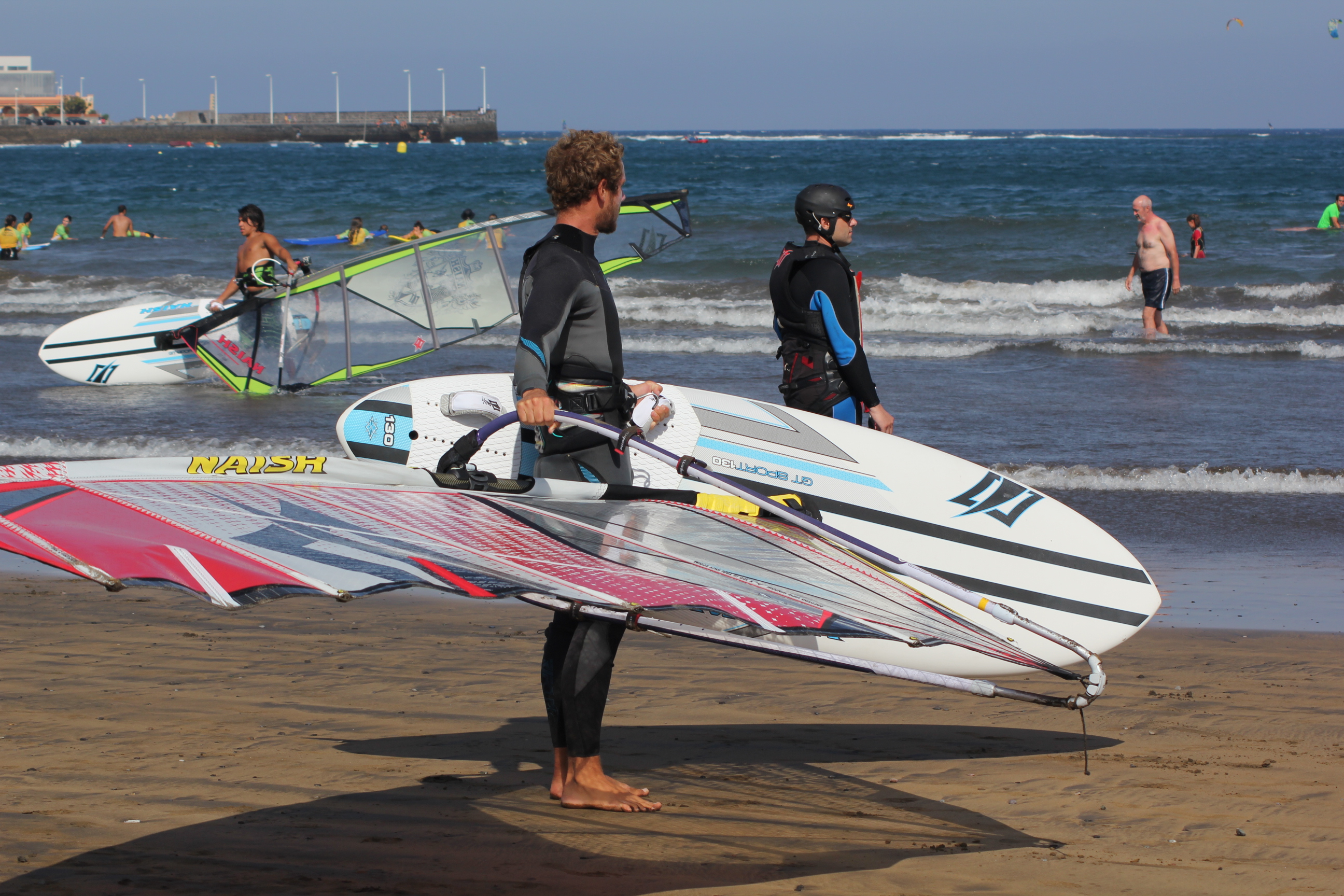
How to carry the Windsurfing Gear
Carrying our windsurfing equipment can be one of the most annoying hassles of the sport if we don’t know how to do it right. Time and again I have seen people carry their windsurf gear in such inefficient ways that this aspect definitely deserves an article. Most of it is common sense but when you are used to a certain way of doing things or don’t adapt your carrying method to the type of equipment and the environment, you will certainly create a habit where you are going to waste a lot o energy in the process of getting your rigged gear to and from the water.
Sails
With enough wind
Above a certain wind speed this method is possible and even if we hardly have any wind, if we run or walk fast we can generate enough aparent wind to make this work.
We can position the sail holding the lower end of the mast and the boom close to the mast or over our heads with one hand on the mast (or boom close to the mast) and the boom. In both of these methods it is important that we keep in mind that tge wind is to do ALL the work. We only need to position the sail correctly relative to the wind. In fact, we literally only need to use TWO FINGERS to carry the sail in wind. If we need more than that, we are doing something wrong. Important to keep in mind is that the mast needs to be on the wind side with the mast foot being slightly more upwind than the boom, and slightly (5 cm, 2 in) more elevated.
With little to no wind
When we have very little wind we won’t have any help from the elements to lift the sail. However, as I mentioned earlier, we can create our own wind by walking fast or running.
Over the head
As with the method with wind, we can balance the sail over our head. One hand will be on the mast and the other in the sail with a flat hand so as to hold it with the maximum surface of the hand. The smaller the hand surface, the more we damage the sail.
DO NOT pull the sail down onto your head!
Our heads have a pretty small surface due to its round shape. The weight of the sail alone laying on top of our heads shouldn’t damage it. However, it we pull the sail down, it’s tge same as if we were standing on it when laying on the ground. At some point it will deform the plastic/cloth/monofilm of the sail.
Big Boards – One person
Daggerboard
If you are strong enough you can lift the board under your arm by grabbing hold of the daggerboard or the daggerboard slot. Just make sure you keep the board on the lee side (downwind of your body) as this way the board is not pressing against you and you can let it swing away from your body, especially useful in the gusts.
(Board on the lee side)
Picture
Over the head
If we need to go upwind we can carry the board on our head (going across the wind or downwind like this can be tricky).
Remember, the board is heavy and has a large surface which means you can easily hurt yourself and others if you lose control of it due to the wind knocking it out of your hands.
Picture
Big Boards – Two people
Large boards are easy to carry between two people since the weight is distributed. The best method is for one person to grab the fin (the board positioned so that the fin is pointing away from the body) and the second person carrying the bow. As mentioned before, it is best if the board is carried on the lee side of the body to make up for the wind pushing the board. Also, when walking in line with the wind, the end with the fin (stern) should be pointing windward.
Buggy
If you are privileged enough to have access to one of these, be sure to use it. It makes your life so much easier. Strap the boards on so that the eind doesn’t blow them off and hurt you or someone else in the process.
Small Boards
Although small boards are lighter and easier to carry than beginner boards, there are indeed ways to carry them that are impracticable and make life hard on us. Here are the methods of how to carry them correctly.
Fin to wind
Before we begin with all the ways, one thing to keep in mind is to always carry the board with the fin end pointing to the wind. This is the position that the board turns to naturally if we carry it at its centre of gravity. It may seem common sense to avoid using energy to fight the wind but I see this a lot on the beach.
Board on the lee side
The other thing to keep in mind is to carry the board on the lee side of our body. This way the wind doesn’t push us sideways but rather we can let the board be lifted by the wind and thereby be less heavy.
Under the arm
Nowadays, with the boards being wider and shorter rather than long and slender, this option of carrying the board in the same fashion as a regular sure board is not always possible.
One footstrap
Grab the lower footstrap and have the other on rest on your forearm. This keeps the board vertical.
Footstrap + mastfoot
Again, keep in mind not to fight against the wind.
Board and Sail Combination
Footstrap + Boom
This is the method I find the best and recommend. It is the one where we have the most control over the gear and so the safest. It is also the one that requires the least energy.
Footstrap + Boom (low wind alternative)
Although it looks similar to the previous one, it is prone to lack of control because the board can start to flap about over the arm holding the footstrap. HOwever, with low wind it is a lilttle easier to carry the gear if it is heavy.
Over the head back footstrap and mast
This consists of holding the mast underneath the boom, leaning the sail on top of your head and the other hand holding the back footstrap. The only time this one is practical is when we have to walk directly upwind. However, even then I recommend the first option as we will always have more control over our gear.
I have seen other methods of carrying the gear but to me they are not the way to go as they are cumbersome and offer less control. If you have any other methods to add, please let me know in the comments.
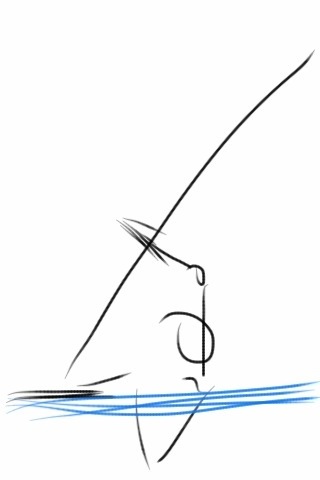
How to Windsurf – The Waterstart
The waterstart: portal to the small volume boards. The manoeuvre that separates the men from the boys, real windsurfers from the newbies, the dedicated from the dabblers…. The waterstart is THE manoeuvre you need to get a hang of to truly enjoy the sport of windsurfing.
If we remember my post on the beachstart, I mention that the beachstart is 95% technique and 5% wind. The waterstart is 80% technique and 20% wind. This means that we can still do a waterstart easily even if the wind drops. However, I have seen so many people unable to sail back to shore when the wind dropped just because their waterstart technique was useless. Therefore I recommend that everybody read this even if they know how to do the waterstart.
The technique of the waterstart is very similiar to that of the beachstart. Basically you can think of the waterstart as a beachstart without touching the ground. Therefore I recommend getting the beachstart technique sorted out before you tackle the waterstart.
Pulling the sail out of the water
I wrote a separate article on how to get the sail out of the water for the waterstart and positioning the gear to save time and energy. You can read up on it now and come back to this post later or finish this one first. For now the main piece of information I want to to take away is that you make sure you keep the sail flat on the water surface to avoid the end of the boom sticking in the water and undoing all your progress of getting the sail to hover out of the water.
Now to the actual waterstart:
We position the board similar to the beachstart, beam reach or slightly more downwind for more sail surface (if there is little wind). We get the board into this position with the same pushing/pulling on the mastfoot as the beachstart only that we need the keep our body more tense as we don’t have a ground to use as fixed point.To get and maintain the board in place we can hold the boom or mast with the front hand and the back footstrap with the back hand.
With these two contact points we can lever the board into place. We can either move on to the next step immediately if we have enough wind or, if we don’t have enough wind, wait for a gust strong enough to lift us out.here is what comes next: Once we have the gear laid out correctly we put the back foot on the board. If there is enough wind we can put both feet on the board which will give us greater control. However, if we use only one foot we can use the other leg to swim upwards and help us get on.
A very important note, when you put your foot on the board DO NOT push the board away from you. You want to lay the foot on the centerline of the board and pull it towards you if anything. Pushing the board away with the back foot will cause the board to turn into the wind and leave us luffed up so far that we no longer have any wind lifting us.
So: lay the back foot on the centerline of the board and push with your front hand onto the mastfoot through the mast. As soon as the foot is on the back hand goes from the back footstrap to the boom (if you didn’t have there already). Once there do not immediately pull down. What you want to do is pull the back hand upwards towards the mast top. Basically over your head. Our intention is to keep the boom horizontal throughout the whole procedure.
As you do this you want to bend your knees and lean your shoulders forwards so that your chest is touching your knees. What this does is in essence position the sail as vertical as possible while bringing your weight centre as low and close over the board as possible. The result is as much sail surface available to the wind to lift us up and the minimum resistance of your bodyweight to pull us down.
Do not sabotage yourself
As soon as we start to get lifted out it is important to avoid two things:
– Bend the front arm
– Lunge forwards with our hips
Both of these will sabotage our efforts and make us fall backwards into the water again. Try to keep this in mind:we want the sail to lift us out of the water with the wind. We DON’T want to pull ourselves up as we would doing pull-ups.
Once our body’s weight centre is over the board we must start to open the sail again to avoid being catapulted over the other side.
And to top it all off we need to keep the boards position steady throughout the whole procedure. As you can see, it is quite a complex maneouvre indeed and one that takes a while to be mastered. I would definitely recommend getting an instructor to guide you for the first two hours as keeping all of these things in mind is nearly impossible… Also, it will stop you from taking up bad habits (especially the front arm and hip lunging thing).
So, to recap:
– Board on beam reach or slightly downwind
– Wait for wind gust if not enough constant wind
– Foot resting on the board, not pushing the board away
– Front arm straight and leaning the mast forward
– Bend knees
– Shoulders forward
– Let the sail lift us up and NOT pull ourselves up
– Open the sail in time
– Maintain board direction steady throughout all manoeuvre
Again, here is the post on lifting the sail out of the water.


